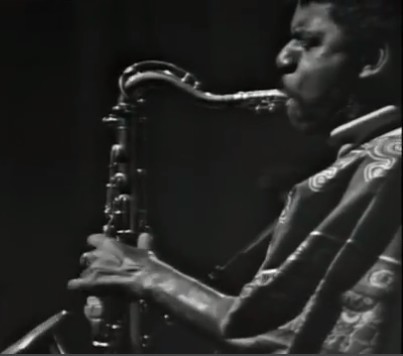Kojo Time – Roland Alexander
An iconic title track for Taru Alexander's tribute album to his father. It is the only song from this album to have been previously recorded. Minus You tracks are available for all instruments.
- Recording: Taru Alexander - Kojo Time
- Recorded on: September 21, 2014
- Label: jazzleadsheets.com (JLS 1020)
- Concert Key: No key center
- Vocal Range: , to
- Style: Swing/Latin (medium up)
- Trumpet - Don Sickler
- Alto Sax - Elijah Shiffer
- Piano - Ben Rosenblum
- Bass - Marty Jaffe
- Drums - Taru Alexander
Video
- Description
- Historical Notes
- Solos
- Piano Corner
- Bass Corner
- Drum Corner
- Guitar Corner
- Inside & Beyond
- Minus You
The solo form is an open vamp on another half-step slash chord, in this case E♭sus over E. A good mode to use for this chord is E Lydian (same as E♭ Phrygian), though the first horn background figure uses an E♭ minor tonality without the E-natural that is in the bass. The vamp uses a Latin groove with a two-measure bass ostinato. On our jazzleadsheets.com recording, the groove begins each solo and eventually transitions to a swinging 4-feel. Two horn background figures are used here for the piano solo, one swing and one Latin.
Click on the Minus You tab for information on how the open, vamp-based solo format works as written on the Minus You parts. For more from this album, click here.
Roland Alexander named Kojo Time for his son Taru, whose middle name is Kojo (African in origin, it means born on Monday). Taru felt it was a fitting title for this tribute album. Unlike the other songs on this album, Kojo Time was recorded by Roland, on an obscure 1978 sextet album "Live At The Axis." At that time, Taru was eleven years old. The trumpeter on "Live At The Axis," Malachi Thompson, arranged Kojo Time for his Africa Brass ensemble (a big band without a sax section) and recorded it in 1994 on his album "Buddy Bolden's Rag."
The open vamp solos provide a unique challenge for the Minus You format. It would be unnatural to count the measures in each open section, especially for a soloist playing with the Minus Melody track. Instead of indicating the length of each solo and each groove, we have decided to use the changes of groove as cues for playing with the Minus You track. Thus the parts include sentences like "vamp until transition to swing." There is one exception: the melody parts indicate how many measures long the first Latin vamp is.
The drum solo on this track is open and mostly out of time. The out melody begins after a final cymbal crash, without any count off. All Minus You tracks have replaced the drum solo on the complete mix track with a single cymbal crash, followed by the out melody; the Minus Melody track has a snap count off (also used at the beginning) to set up the out melody. The count off for the beginning of the other tracks is Taru's clicking his sticks together for five beats; there is no verbal count off.
MP3 This is the form of the full track:
-- melody
-- alto sax solo: Latin vamp, then swing vamp
-- trumpet solo: Latin vamp, then swing vamp
-- piano solo: Latin vamp, then swing vamp
-- horn background 1 for piano solo four times (swing)
-- eight more measures of piano solo (swing)
-- horn background 2 for piano solo two times (Latin)
-- drum solo: open
-- out melody
mp3 minus melody The horn backgrounds have been left in. Eight measures of Latin vamp have been kept from the piano solo before the first background; there is no piano here. The piano comes back on the second time through background 2.
-- click count off sets up the melody
-- play the melody
-- solo: 48 measures Latin vamp, then swing vamp until Latin
-- continue solo: eight measures Latin vamp with bass and drums only, then continue over horn background 1 (four times, swing)
-- continue solo: eight measures swing vamp with bass and drums only, then continue over horn background 2 (two times, Latin)
-- cymbal crash, snap count off sets up the out melody
-- play the out melody
mp3 minus Piano
-- click count off sets up the melody
-- play figures and comp for the melody
-- comp for the alto sax and trumpet solos: Latin vamp, then swing vamp (each soloist)
-- solo: Latin vamp, then swing vamp
-- continue solo over horn background 1 (four times, swing)
-- continue solo: eight measures, swing
-- continue solo over horn background 2 (two times, Latin) to cymbal crash
-- play figures and comp for the out melody
mp3 minus Bass
-- click count off sets up the melody
-- play figures and walk for the melody
-- play line and walk for the alto sax, trumpet, and piano solos: Latin vamp, then swing vamp (each soloist)
-- continue walking for the piano solo over horn background 1 (four times) and eight more measures of piano solo
-- Latin vamp for piano solo over horn background 2 (two times) to cymbal crash
-- play figures and walk for the out melody
mp3 minus Drums
-- click count off sets up the melody
-- play figures and comp for the melody
-- comp for the alto sax, trumpet, and piano solos: Latin vamp, then swing vamp (each soloist)
-- continue comping for the piano solo: horn background 1 (four times, swing), eight more measures of swing, horn background 2 (two times, Latin) to a cymbal crash
-- play figures and comp for the out melody
mp3 Bass & Drums only - to feature piano, guitar, vibes, or any melodic instrument that likes to play without harmonic accompaniment.
-- click count off sets up the melody
-- play the melody
-- solo: 48 measures Latin vamp, then swing vamp until Latin
-- continue solo: eight measures Latin vamp, then continue (four times, swing)
-- continue solo: eight measures swing vamp, then continue (two times, Latin)
-- cymbal crash, click count off sets up the out melody
-- play the out melody
Related Songs
Email Send Kojo Time to a friend

Roland Alexander
September 25, 1935 – June 14, 2006
Although he never received the credit he was due, the versatile tenor saxophonist Roland Alexander started his career with an unexpected break at age twenty when he made his recording debut—on piano. Born and raised in Boston, Massachusetts, Roland was trained both formally at Boston Conservatory and through day-to-day gig experience, so he was skilled enough to step in when the scheduled pianist (believed to be Red Garland) didn’t make a Paul Chambers session that Roland was observing on April 20, 1956. He was asked to sit in on piano for the blues Trane’s Strain, which was quite a break for the young musician, as the other players on the session were well-known names like John Coltrane, Curtis Fuller, Pepper Adams, and the rest of Miles Davis' current rhythm section, Paul Chambers on bass and Philly Joe Jones on drums. Read more...

